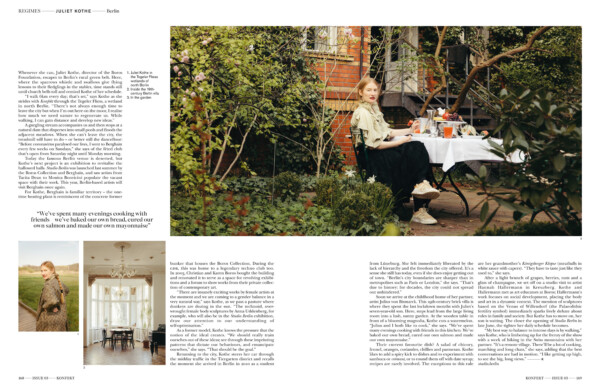Ilona Marx
Editorial work / Concepts / Texts
The Lady in the Fen
Art & Culture
As often as she can, Juliet Kothe, director of the private museum Sammlung Boros, takes short escapes to the rural surroundings of Berlin. Here, where the sparrows whistle and swallow give flying lessons to their fledglings in the horse stables, time seems to stand still until the church bells remind her to move on with her busy schedule.
„I walk six kilometres every day. That‘s set,” says curator Juliet Kothe as she strides with Konfekt through the Tegeler Fließ, a wetland in the north of Berlin. “There‘s not always enough time to leave the city, but when I‘m out here on the moor, I always realise how much we need nature to regenerate. While walking, I can gain distance and develop new ideas.“
The gurgling stream accompanies us and then stops at a natural dam which disperses into small pools and floods the adjacent meadows. When she can’t get out of the city the treadmill will have to do – or better still the dancefloor: „Before Corona paralysed our lives, I used to go to Berghain every few weeks on Sundays,“ she says of her outings to the techno club which opens its doors on Saturday night and doesn‘t close them again until Monday morning.
At the moment, the famous Berlin venue is deserted but Kothe’s next project is an exhibition concept intended to temporarily revitalise the hallowed techno halls. Studio.Berlin was launched last summer by the Boros Collection and Berghain and saw artists from Tacita Dean to Monica Bonvicini populate the vacant space with their work. The project is poised to enter a new round and will see Berlin-based artists visit Berghain once again.
For Kothe, Berghain is familiar territory: the former district heating plant is reminiscent of the concrete bunker that houses the Boros Collection where she is director. Before art moved in here, this too was home to a legendary techno club. In 2003, Christian and Karen Boros bought the building and renovated it to serve as a space for revolving exhibitions and a forum to show works from their 850-strong contemporary private collection. „There are insanely exciting works by female artists at the moment, and we are coming to a gender balance in a very natural way,“ says Kothe of her work, as we pass a pasture where half a dozen donkeys are dozing in the sun. „The technoid, overwrought female body sculptures by Anna Uddenberg, for example, who will also be in the Studio.Berlin exhibition, draw our attention to our understanding of self-optimisation.“
As a former model, Juliet Kothe knows the pressure that the idea of the ideal creates. „We should really train ourselves out of these ideas,” she says. “[We need] to see through these imprinting patterns [that dictate] our behaviours and emancipate ourselves, that should be the goal. It‘s a process of getting closer and closer to yourself.“
On the way back to the city, Kothe steers her Mercedes station wagon through the midday traffic in the Tiergarten district and recalls the moment she arrived in Berlin in 2010 after studying in Lüneburg. She felt immediately liberated by the lack of hierarchy and the freedom the city offered. It’s a sense she still has today, even if she does enjoy the contrast of getting out of town. „In Berlin, the city boundaries are sharper than in metropolises like Paris or London, that‘s due to history. For decades, the city could not spread out unhindered,” she says.
Before long we arrive at the childhood home of her partner, the artist Julius von Bismarck. This 19th century brick villa was where they spent the last lockdown months with Juliet‘s 7-year-old son Valentin. Here, steps lead from the large living room into a lush, sunny garden. At the wooden table in front of the magnolia, Juliet cuts up a cantaloupe melon. „Julius and I both like to cook,” she says. “We spent many evenings cooking with friends in this kitchen. We‘ve baked our own bread, cured our own salmon and made our own mayonnaise.“
Their current favourite dish together: a salad of chicory, fennel, oranges, coriander, chillies and parmesan. Kothe likes to cook dishes with a spicy kick; and to experiment with sambuca or crémant or to round off her dishes with date syrup. (Recipes are almost never involved.) There is only one exception to this rule: her grandmother‘s Königsberger Klopse [meatballs in white sauce with capers.] „They just have to taste just like they used to,“ Kothe says with a laugh.
After a light brunch, we set off again. A studio visit to artist Hannah Hallermann in Neukölln is still on the agenda. Kothe and Hallermann know each other from their time together as art educators at Boros, and Hallermann will also be showing at Studio.Berlin. Her works deal with social development, placing the body and the artwork in a dynamic context. A lively debate about role patterns in family and society immediately sparks over the sculptures still in-the-making, (these are based on the depiction of the Palaeolithic fertility symbol Venus von Willendorf.) But Kothe has to move on, Valentin is waiting. The closer the opening date of the Studio.Berlin exhibition gets, the tighter her daily schedule becomes.
“My best balance to intense days with a lot and different work is walking,” says Kothe, adding that before she limbers up for the intense weeks of work prior to the show in June, she is taking some time off. She is going to the Swiss mountains with Julius and Valentin for a week of hiking.
Konfekt,
March 2022

